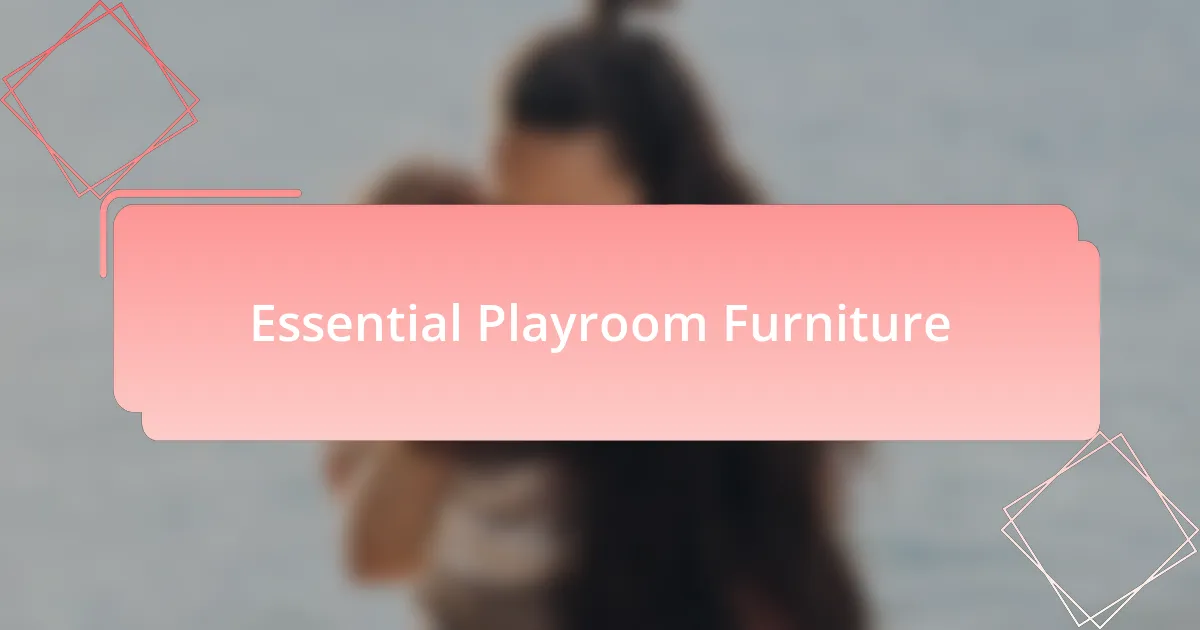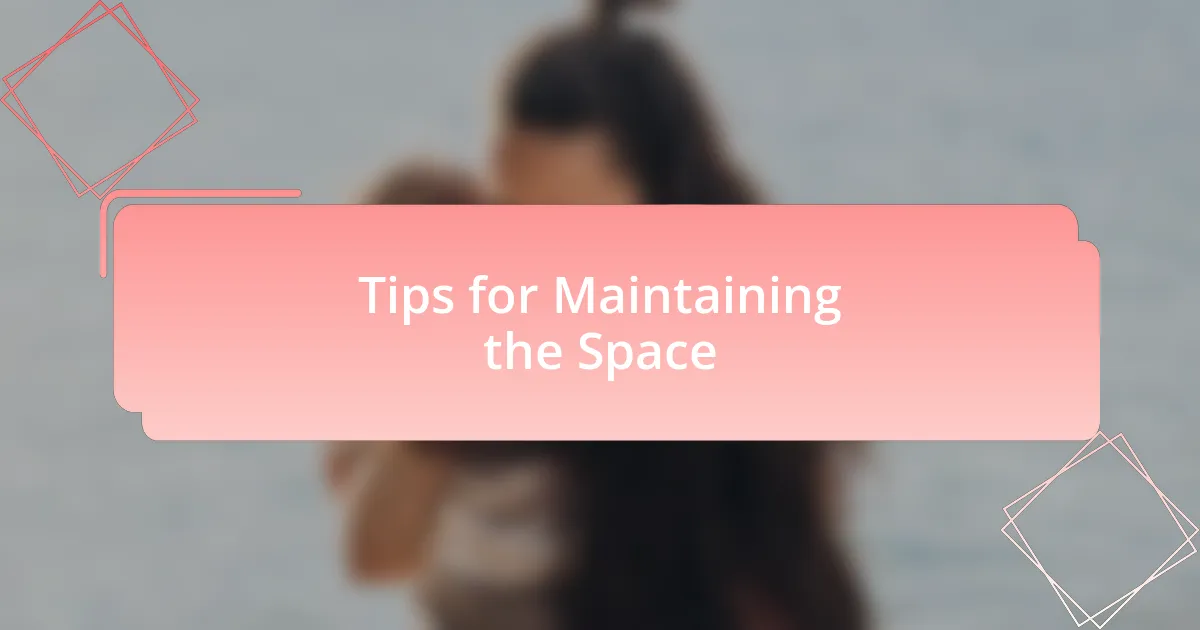Key takeaways:
- A well-designed playroom enhances children’s creativity and imagination by reflecting their interests with themed areas and organized spaces.
- Dedicated playrooms benefit both children and parents by promoting active play, reducing clutter, and encouraging social interactions.
- Choosing versatile furniture and safety considerations are essential for creating a flexible and accessible environment for children.
- Personalizing the playroom with children’s artwork and involving them in the design process fosters a sense of ownership and pride in their space.

Understanding Playroom Concepts
When I first considered transforming my attic into a playroom, I realized that a playroom is more than just a space filled with toys; it’s a world where imagination comes alive. I remember watching my children joyfully creating stories and adventures with their toys, and it made me think about how the design and organization of that space could enhance their experience. Isn’t it fascinating how a room can spark creativity?
One key concept I learned is that a playroom should reflect the interests and ages of your children. Initially, I filled the space with general toys, but after observing my kids, I realized that a few focused themes—like a reading nook or an arts corner—could make the space more engaging for them. Have you ever noticed how a child can be drawn into a specific activity when it’s tailored to their interests? That was a game-changer for me.
Additionally, I found that incorporating elements like soft seating, open floor space, and storage solutions made a significant difference. Once, while playing in the newly organized attic, my kids excitedly invited their friends over. The joy on their faces as they explored their playroom filled with cozy corners and bright colors reassured me that I had made the right decisions. Designing a playroom should truly be about creating a joyful environment that encourages exploration and play.

Benefits of a Playroom
Creating a playroom offers extensive benefits for both children and parents. For instance, I’ve seen that having a dedicated space for play encourages my kids to be more active and imaginative. They spend hours engrossed in their worlds, and it’s heartwarming to witness their creativity flourish away from screens. How often do we wish for moments where children are fully engaged and happy?
Another advantage is the organization it brings to our home. Before, toys were scattered throughout the house, causing clutter and making it hard to find anything. Now, with everything neatly arranged in the playroom, clean-up has become a team activity. I’ve also come to appreciate how this intentional space reduces distractions during playtime, allowing my children to focus and really dive into their imaginative adventures. Isn’t it incredible how a simple change in environment can lead to such positive outcomes?
Furthermore, a playroom plays a crucial role in facilitating social interactions. I’ve noticed that our attic transformation has become a favorite spot for playdates, fostering relationships among my children and their friends. Watching them collaborate on games or invent new ones together fills me with joy. The laughter and chatter echoing from that room remind me that a playroom is not just about toys; it’s about creating lasting memories and friendships.

Planning Your Attic Layout
When planning your attic layout, I found it essential to envision the flow of the space. I remember sketching out a rough design that highlighted distinct areas for different activities, like art corners and reading nooks. How often do we underestimate the importance of a well-organized play area? It can truly inspire creativity and play.
Another key aspect is to consider the furniture and storage solutions you’ll need. I chose lightweight, multifunctional pieces that allowed for easy rearranging, which has made the space adaptable as my children’s interests change. The right furniture can create an inviting atmosphere; have you noticed how certain colors or shapes can impact mood? I learned that a few bright cushions or a funky bookshelf can really lighten things up.
Don’t forget about safety and accessibility! Ensuring that all toys and materials are within reach for little ones made a significant difference in how they interacted with their new environment. One day, as I watched my youngest effortlessly grab his favorite building blocks, I remembered how crucial it is for children to feel empowered in their space. Isn’t it rewarding to see them thrive in an area designed just for them?

Choosing Playroom Themes
When choosing a theme for the playroom, I found it helpful to consider my children’s interests and personalities. For instance, my daughter loves the ocean, so we went with a beach theme complete with soft blues and sandy textures. This not only made her excited about the space but also gave me a sense of joy watching her play in a room that felt like an escape into her favorite world. Have you ever noticed how a theme can transform a mundane space into something magical?
As I decorated, I also thought about incorporating educational elements into the theme. A colorful jungle theme, for example, could spark curiosity about animals and nature. I remember adding a tree mural and animal plushies, which encouraged imaginative play while subtly teaching my kids about wildlife. Isn’t it fascinating how a well-chosen theme can blend learning with play?
Lastly, I believe it’s important to keep flexibility in mind. I intentionally selected a neutral color base that allows for easy updates as their interests evolve, like a simple white wall that can be layered with fun, removable decals. This way, I can easily switch from a fairy-tale theme to a space adventure without a complete overhaul. How do you think your children’s ever-changing preferences can influence your design choices?

Essential Playroom Furniture
When it comes to essential playroom furniture, I discovered that a sturdy table and chairs set is a must-have. My kids love to engage in arts and crafts, and having a designated space for these activities made clean-up so much easier. I remember selecting a bright, colorful set that inspires creativity and really brings the room together—there’s just something about those vivid hues that makes the space feel alive, don’t you think?
Another key piece I found invaluable is ample storage for toys. I opted for stylish bins that not only keep the clutter at bay but also add a splash of fun to the decor. Seeing my children delight in tidying up their playroom, all while learning about organization, was a win-win—a small triumph that made me realize how the right furniture can teach valuable life skills.
Lastly, I can’t emphasize enough the importance of comfortable seating. A cozy reading nook with cushioned bean bags instantly became my little ones’ favorite spot for storytime. I vividly recall the peaceful afternoons spent together, curled up in those soft, inviting chairs, sharing tales and laughter—a cherished bonding experience that I hope they’ll remember fondly as they grow. What pieces of furniture have shaped your family’s playtime moments?

Personalizing Your Playroom
When personalizing your playroom, I found that adding your child’s favorite themes can truly transform the space. My daughter absolutely adores unicorns, so we incorporated whimsical wall decals and soft, plush unicorn décor. It wasn’t just about decorating; seeing her eyes light up every time she enters the room brings a special warmth to our home. What themes would ignite joy in your little one’s heart?
I also discovered that involving my kids in the personalization process made a significant difference. We sat together and crafted a mood board, choosing colors, art, and even a fun name for the playroom. Their excitement was contagious, and I realized that ownership of the space fosters a sense of belonging and creativity. How does your child express their individuality?
Lastly, I think incorporating their artwork into the décor adds a unique touch that feels personal. I’ve hung up their drawings in frames we painted together, creating a mini-gallery that showcases their creativity. Each piece tells a story, and I love hearing them explain their artwork to visitors. It sparks a sense of pride and encourages them to express themselves, and I can’t help but wonder what masterpieces your child might share with the world!

Tips for Maintaining the Space
Maintaining a playroom requires a regular cleaning schedule that can easily integrate into your family’s routine. I like to set aside a specific day each week for a thorough decluttering session. Not only does it keep the space looking tidy, but it also teaches my kids the value of organization. What cleaning habits do you think would work best for your family?
I’ve also found that rotating toys every few months makes a world of difference. This keeps the playroom feeling fresh and inviting. When I packed away some of my children’s toys and took them out later, their excitement was palpable as if they were brand-new. Have you tried this simple trick to spark your child’s imagination?
Another essential tip is to involve your kids in the upkeep of their playroom. I encourage mine to help with simple tasks, like sorting toys into bins or organizing books on shelves. This not only eases your workload but also instills responsibility in them. How do your children contribute to maintaining their space?